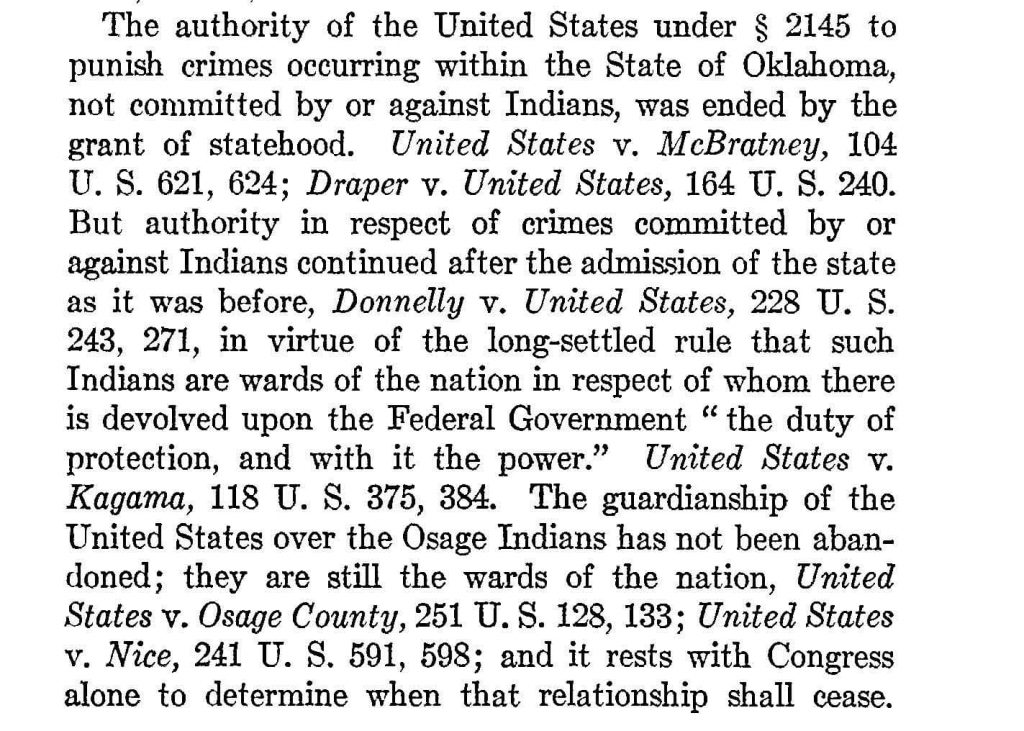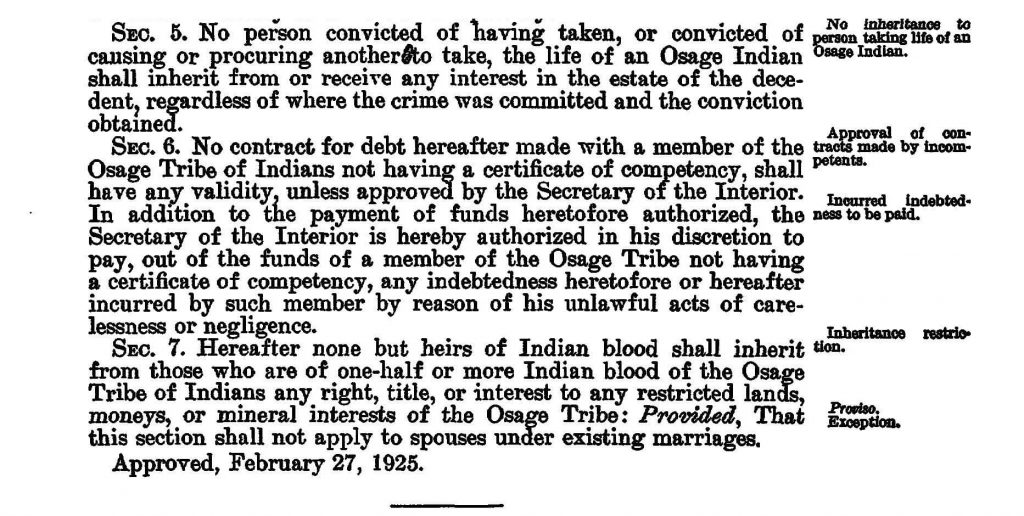Earlier this week on the HeinOnline Blog, we dove into the Serial Set to explore indigenous peoples’ struggles to gain suffrage and citizenship. In that post, we briefly explored the 1887 Dawes Act,[1]24 Stat. 388. This act is found in HeinOnline’s U.S. Statutes at Large. which divided communal tribal lands into allotments, forcing tribes into practicing private property. In this post, we will explore the deadly results of one nation’s relationship with allotments: the Osage Nation’s oil headrights and the subsequent Osage murders.
The Osage and a Brand New State
The Osage Nation[2]Lester Hargrett. Bibliography of the Constitutions and Laws of the American Indians (1947). This book is found in HeinOnline’s Indigenous Peoples of Americas: History, Culture & Law. is a tribe of the Great Plains whose ancestral lands stretched across Missouri, Arkansas, and Oklahoma. But by the early 19th century, the Osage Nation had been corralled onto a reservation in Kansas. In 1872, the Osage people were relocated to a reservation in the Oklahoma territory. Congress purchased the land in Oklahoma on behalf of the Osage Nation[3]17 Stat. 228. This act is found in HeinOnline’s U.S. Statutes at Large. using proceeds from the sale of their land in Kansas, essentially resulting in the Osage purchasing their own reservation.
As the 19th century crept to a close, oil was discovered in Indian country. The first oil lease on the Osage reservation was issued to Henry Foster on March 16, 1896 for a period of ten years[4]Summer L. Carmack, Loyalties and Royalties: The Osage Nation’s Energy Sovereignty Plan and Wind Farm Opposition, 40 Pub. Land & Resources L. Rev. 145 (2019). This article is in HeinOnline’s Law Journal … Continue reading The rocky, barren land of Indian country was now suddenly more valuable than the federal government had realized.
Allotments and Headrights
In the midst of this oil boom, Oklahoma was seeking statehood. In 1906, one year before Oklahoma was admitted to the Union, Congress passed the Osage Allotment Act.[5]34 Stat. 539. This act is found in HeinOnline’s U.S. Statutes at Large. The Act divided the reservation’s surface land into allotments that were assigned to every man, woman, and child appearing on the tribal roll. But because the Osage Nation was the last tribe subjected to allotment, and because the federal government badly wanted to increase the amount of land in the new state of Oklahoma available to white settlers, Osage tribal leaders were in a uniquely powerful position to lobby for their people.
Under the Act, rights to the oil, gas, and minerals below the land’s surface would remain under tribal control for the next twenty-five years. The oil, gas, and mineral rights profits were held in tribal trust and every person appearing on the tribal roll was given a headright,[6]Rennard Strickland, Osage Oil: Mineral Law, Murder, Mayhem, and Manipulation, 10 Nat. Resources & Env’t. 39 (1995). This article is in HeinOnline’s Law Journal Library. or an equal portion of the royalties from the mineral estate. These headrights could be inherited but they could not be bought or sold. 2,229 people[7]Summer L. Carmack, Loyalties and Royalties: The Osage Nation’s Energy Sovereignty Plan and Wind Farm Opposition, 40 Pub. Land & Resources L. Rev. 145 (2019). This article is in HeinOnline’s Law Journal … Continue reading were listed on the original Osage tribal roll, and 2,229 headrights were issued.

Black Gold and Black Motives
As oil pumped from the Oklahoma ground, money flowed into the Osage Nation’s trust account. Headrights made members of the Osage Nation “the richest people in the word.“[8]Summer L. Carmack, Loyalties and Royalties: The Osage Nation’s Energy Sovereignty Plan and Wind Farm Opposition, 40 Pub. Land & Resources L. Rev. 145 (2019). This article is in HeinOnline’s Law Journal … Continue reading Estimates on the amount of money earned through headrights vary; one account claimed each member earned $10,000 annually[9]C. B. Glasscock. Then Came Oil: The Story of the Last Frontier (1938). This title is found in HeinOnline’s Indigenous Peoples of Americas: History, Culture & Law. and a 1939 Congressional hearing estimated that approximately $21 million[10]United States. Osage Tribe of Indians : Hearings before the Committee on Indian Affairs, United States Senate, Seventy-Sixth Congress, First Session on S. 1298 .. (1939). had been cumulatively earned up to that point. In 2022 dollars, these figures would range from $215,000 to $540,000,000. Just last year, one headright paid out $15,790.
Greed, naturally, grew out of this immense wealth. The Hominy Trading Post, which sold food, clothing, farming tools, and even provided funeral services, charged its Osage Indian customers separate, hugely inflated prices over white customers; the markup could be as high as 500%. A Congressional investigation in 1915 uncovered instances of white settlers loaning money to Osage peoples at an interest rate of 10,220%.[11]Report of Joint Commission to Investigate Indian Affairs, H.R. 1669 (1915). This report is found in HeinOnline’s U.S. Congressional Serial Set.
But usury was not the only crime committed against the Osage. At the height of the oil boom, the murders started.
Osage Murders and the Reign of Terror
On May 28, 1921, the bodies of Anna Brown and her cousin, Charles Whitehorn,[12]C. B. Glasscock. Then Came Oil: The Story of the Last Frontier (1938). This title is found in HeinOnline’s Indigenous Peoples of Americas: History, Culture & Law. were found by hunters. Both were members of the Osage tribe. Because Anna Brown was divorced, her headrights passed to her mother, Lizzie Q. Two months later, Lizzie was dead.
In February 1923, Henry Roan was found dead in his car, shot in the head. Roan was a cousin of Anna Brown. The next month, the home of Rita and Bill Smith was bombed while the family slept; Rita and a servant were killed instantly in the blast, and Bill later died of his injuries. Rita was Anna Brown’s sister.
The murders were dubbed by the press as the “Reign of Terror,”[13]Rennard Strickland, Osage Oil: Mineral Law, Murder, Mayhem, and Manipulation, 10 Nat. Resources & Env’t. 39 (1995). This article is in HeinOnline’s Law Journal Library. and although the perpetrator was unknown, the motive was clear: Lizzie Q. and her descendants were incredibly wealthy thanks to their headrights. Someone was targeting the family.
After the tribal roll of the Osage nation was closed in 1908, no additional headrights were issued. In theory, this restricted headrights to the family lineage of the original 2,229 allotees. But that did not stop people from finding a way to circumvent these protections. White settlers married Osage people with dubious motives, hoping to inherit. Another popular way to gain access to headrights was to have an individual declared incompetent. Guardians, usually white, were then appointed to manage their claims. These guardians were often unscrupulous at best and malicious at worst.
In June 1923, George Bigheart, son of the legendary Osage chief James Bigheart, was hospitalized, exhibiting signs of poisoning. Bigheart met with his lawyer, W.W. Vaughn, in his hospital room. It is not clear what the two men discussed. But shortly after Bigheart’s death, Vaughn’s body was found beside the railroad tracks.
The King of Osage Hills
The headrights belonging to Lizzie Q. and her descendants eventually passed to Lizzie’s last living daughter, Mollie, and Mollie’s white husband, Ernest Burkhardt. Burkhardt was the nephew of William Hale, a wealthy white rancher known as “King of Osage Hills.” As for Mollie, she was exhibiting signs of poisoning, in danger of being the next Osage murder victim.
An eventual investigation by the Bureau of Investigation (BOI), the precursor to the Federal Bureau of Investigation (FBI), uncovered the conspiracy at the heart of all this death—with William Hale as the ringleader.
Under Hale’s orders, John Ramsey, a local rancher, killed Henry Roan. Not so coincidentally, Hale was the beneficiary of Henry Roan’s $25,000 life insurance policy.[14]C. B. Glasscock. Then Came Oil: The Story of the Last Frontier (1938). This title is found in HeinOnline’s Indigenous Peoples of Americas: History, Culture & Law. Ramsey also confessed to bombing the Smith home and named Henry Grammar and Asa Kirby as his accomplices, again all hired by Hale. Suspiciously, Grammar and Kirby had both been murdered.[15]C. B. Glasscock. Then Came Oil: The Story of the Last Frontier (1938). This title is found in HeinOnline’s Indigenous Peoples of Americas: History, Culture & Law.
Hale, Ramsey, and Burkhardt were arrested and tried for the murder of Henry Roan. Ernest Burkhardt confessed,[16]C. B. Glasscock. Then Came Oil: The Story of the Last Frontier (1938). This title is found in HeinOnline’s Indigenous Peoples of Americas: History, Culture & Law. pled guilty, and turned state’s evidence, implicating his brother in Anna Brown’s murder. Burkhardt maintained that William Hale was the mastermind behind the Osage murders.
United States v. Ramsey
William Hale and John Ramsey’s state trial in 1926 for the murder of Henry Roan ended in a mistrial. Since Roan’s murder had taken place on the reservation, the two were then indicted on federal charges. Hale and Ramsey’s lawyers argued the federal government did not have jurisdiction. The case, United States v. Ramsey,[17]271 U.S. 467. This case is in HeinOnline’s U.S. Supreme Court Library eventually went to the U.S. Supreme Court, where the Court ruled that the allotment land where Roan was killed was “Indian country” and under federal jurisdiction.

John Ramsey, Ernest Burkhardt, and William Hale were all convicted and sentenced to life in prison for the murder of Henry Roan. Ramsey and Hale both appealed their convictions, were retried, and resentenced to life. Despite the sentences, both John Ramsey and William Hale were paroled in 1947. Ernest Burkhardt was released in 1959 and granted a full pardon by Oklahoma Governor Henry Bellmon in 1965.
Henry Roan, Lizzie Q., and the rest of her family were not the only Osage peoples murdered for their headrights. It is unknown how many were killed; most estimates range from 24 to 60 people, or approximately 1–3% of the Osage Nation.[18]Rennard Strickland, Osage Oil: Mineral Law, Murder, Mayhem, and Manipulation, 10 Nat. Resources & Env’t. 39 (1995). This article is in HeinOnline’s Law Journal Library.
In response to the murders, in 1925 Congress amended the Osage Allotment Act[19]43 Stat. 1011. This act is found in HeinOnline’s U.S. Statutes at Large. to prohibit non-blood Osage heirs from inheriting headrights.

In 2011, decades of litigation between the Osage Nation and the United States over mismanagement of the Osage trust accounts by the Department of the Interior was settled. The tribe was awarded $380 million in compensation.
HeinOnline Sources[+]
| ↑1 | 24 Stat. 388. This act is found in HeinOnline’s U.S. Statutes at Large. |
|---|---|
| ↑2 | Lester Hargrett. Bibliography of the Constitutions and Laws of the American Indians (1947). This book is found in HeinOnline’s Indigenous Peoples of Americas: History, Culture & Law. |
| ↑3 | 17 Stat. 228. This act is found in HeinOnline’s U.S. Statutes at Large. |
| ↑4, ↑7, ↑8 | Summer L. Carmack, Loyalties and Royalties: The Osage Nation’s Energy Sovereignty Plan and Wind Farm Opposition, 40 Pub. Land & Resources L. Rev. 145 (2019). This article is in HeinOnline’s Law Journal Library. |
| ↑5 | 34 Stat. 539. This act is found in HeinOnline’s U.S. Statutes at Large. |
| ↑6, ↑13, ↑18 | Rennard Strickland, Osage Oil: Mineral Law, Murder, Mayhem, and Manipulation, 10 Nat. Resources & Env’t. 39 (1995). This article is in HeinOnline’s Law Journal Library. |
| ↑9, ↑12, ↑14, ↑15, ↑16 | C. B. Glasscock. Then Came Oil: The Story of the Last Frontier (1938). This title is found in HeinOnline’s Indigenous Peoples of Americas: History, Culture & Law. |
| ↑10 | United States. Osage Tribe of Indians : Hearings before the Committee on Indian Affairs, United States Senate, Seventy-Sixth Congress, First Session on S. 1298 .. (1939). |
| ↑11 | Report of Joint Commission to Investigate Indian Affairs, H.R. 1669 (1915). This report is found in HeinOnline’s U.S. Congressional Serial Set. |
| ↑17 | 271 U.S. 467. This case is in HeinOnline’s U.S. Supreme Court Library |
| ↑19 | 43 Stat. 1011. This act is found in HeinOnline’s U.S. Statutes at Large. |



